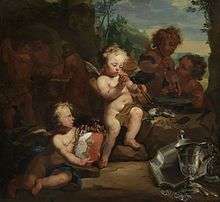Matthias de Visch

Matthias de Visch or Matthijs de Visch (22 March 1702 in Reninge – 1765 in Bruges) was a Flemish painter of history paintings and portraits.[1]
Life
He was a pupil of Joseph van den Kerckhove in Bruges. To continue his artistic training, he travelled to Paris and Italy, returning in 1732. He gave art lessons at his home from 1735 and played a key role in the reopening of the Bruges Academy of Art in 1739. He acted as its director from then until his death.[2] The Academy played a pioneering role in promoting neoclassicism in the Southern Netherlands.[2][3] In 1737 he married Petronilla Iweins.[4]
His pupils included Jean Garemyn, Paul de Cock, Pieter (I) Pepers, Jacques de Rijcke, and Joseph-Benoît Suvée.[1]
Work
De Visch painted diverse subjects, but is primarily known for his religious scenes and portraits. His style has a late-Baroque character, but can be regarded a transitional to the rococo in particular in his use of soft tones.[4]
References
- 1 2 Matthias de Visch at the Netherlands Institute for Art History (Dutch)
- 1 2 Jean Garemyn in: Michael Bryan, Dictionary of painters and engravers, biographical and critical (Google eBook), 1849
- ↑ Virginie D'haene, Bruges Artists Abroad: Neoclassicist Drawings in the Printroom of the Groeningemuseum, in: Codart eZine Summer 2014
- 1 2 Dominiek Dendooven & Joël Snick, Matthijs De Visch, (met proeve van volledige inventaris van de schilderwerken door Matthijs de Visch), Davidsfonds Reninge, 2001.
External links
-
 Media related to Matthias de Visch at Wikimedia Commons
Media related to Matthias de Visch at Wikimedia Commons - (Dutch) The Bruges academy in the 18th century